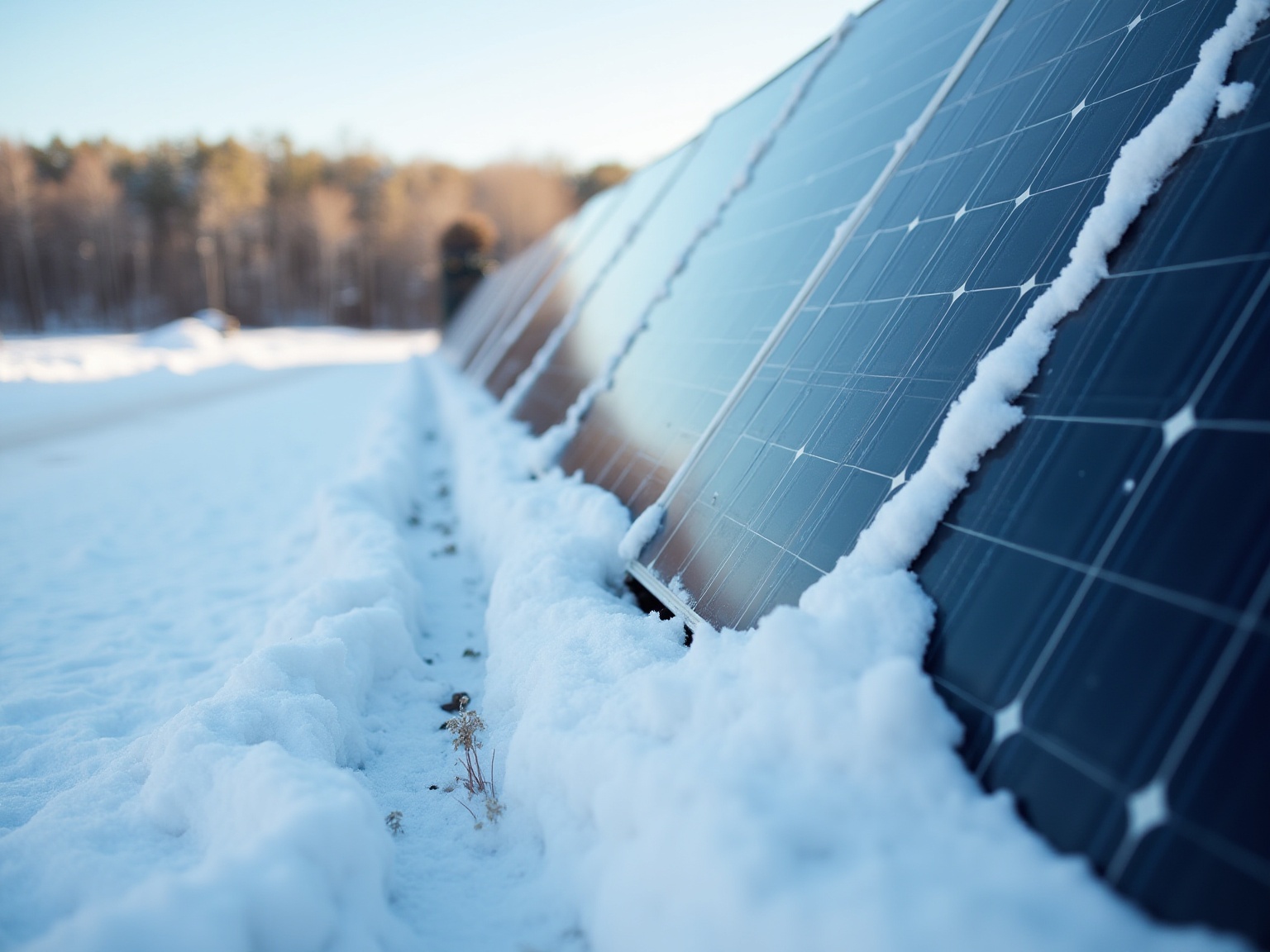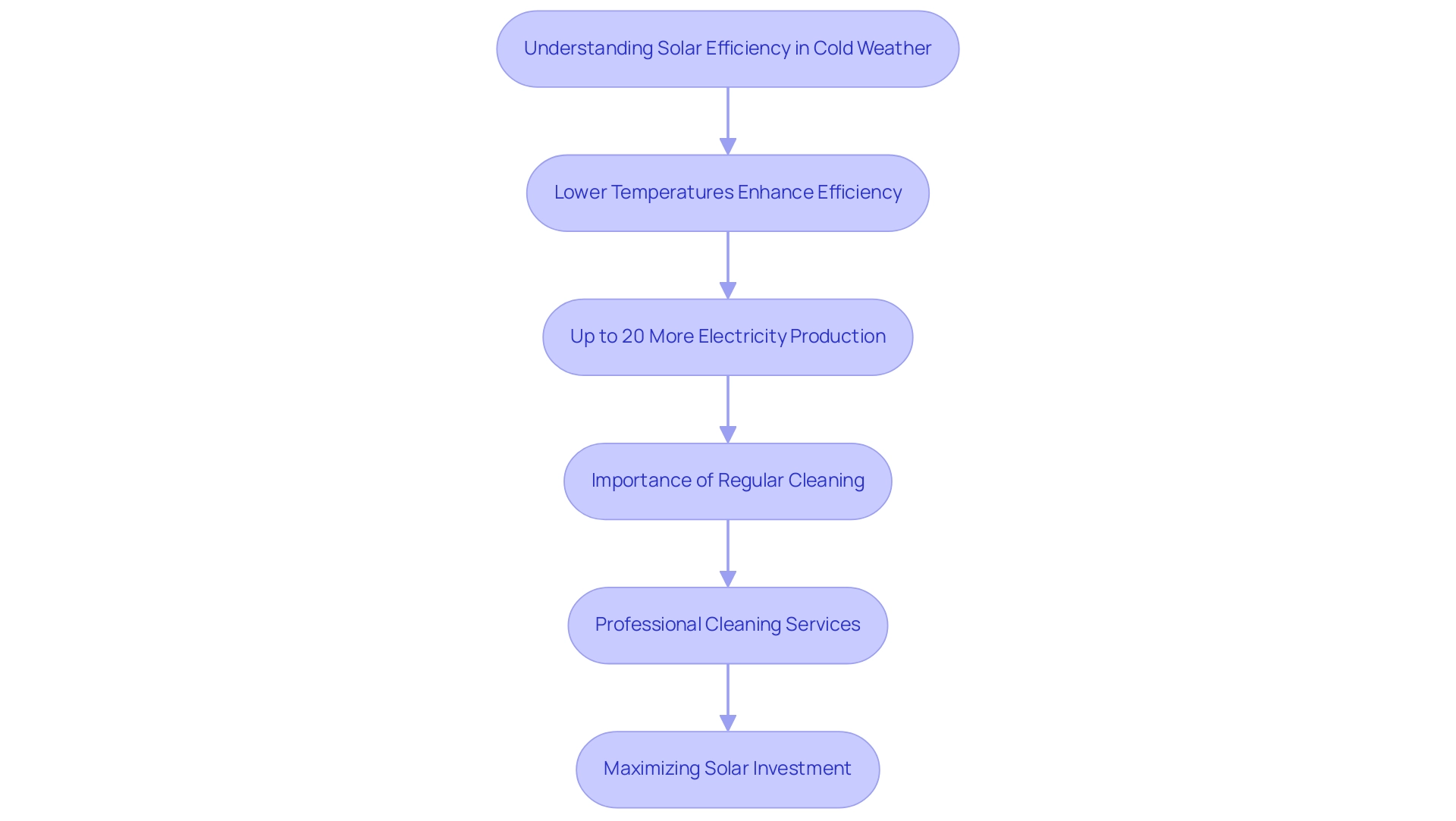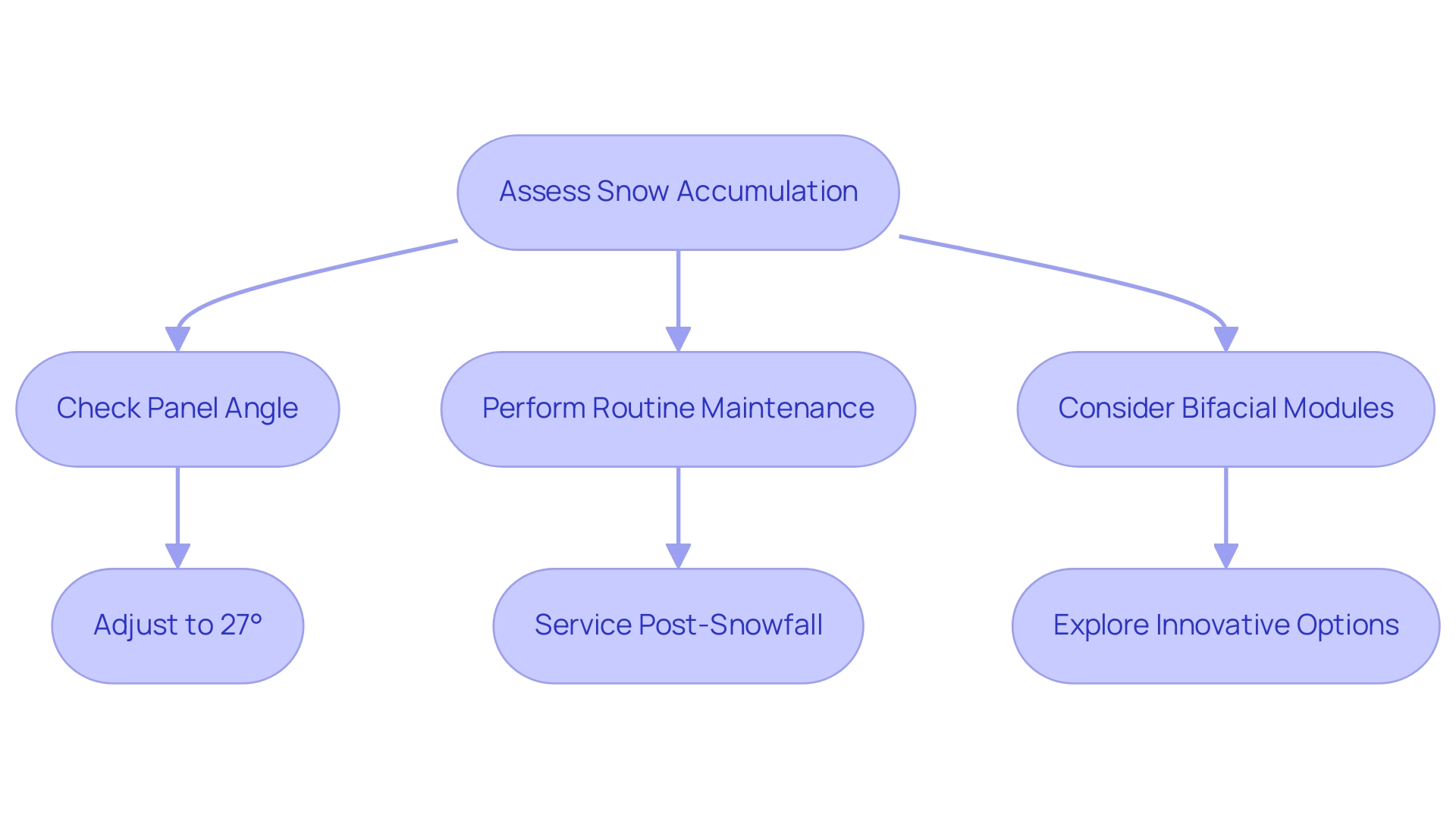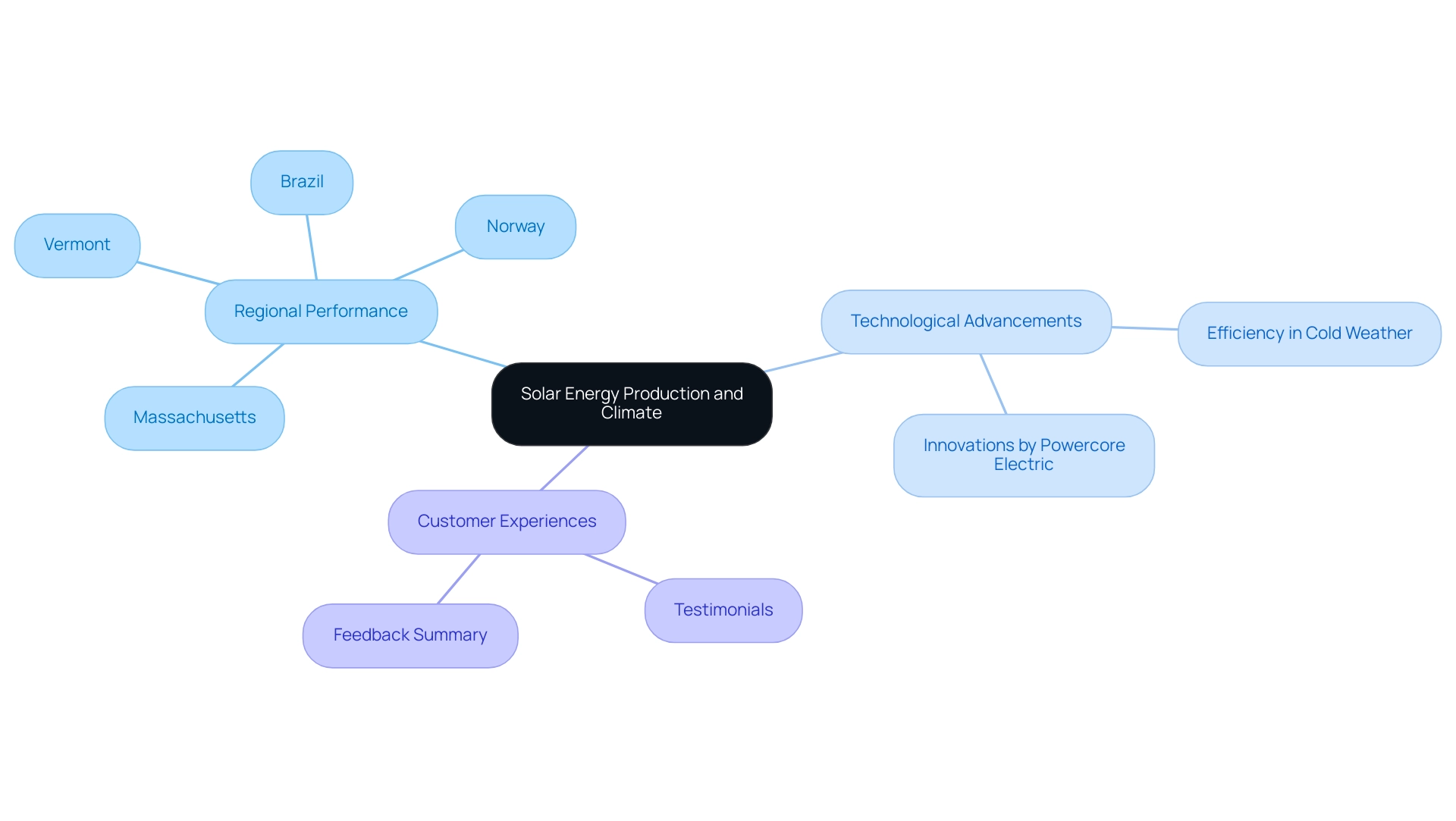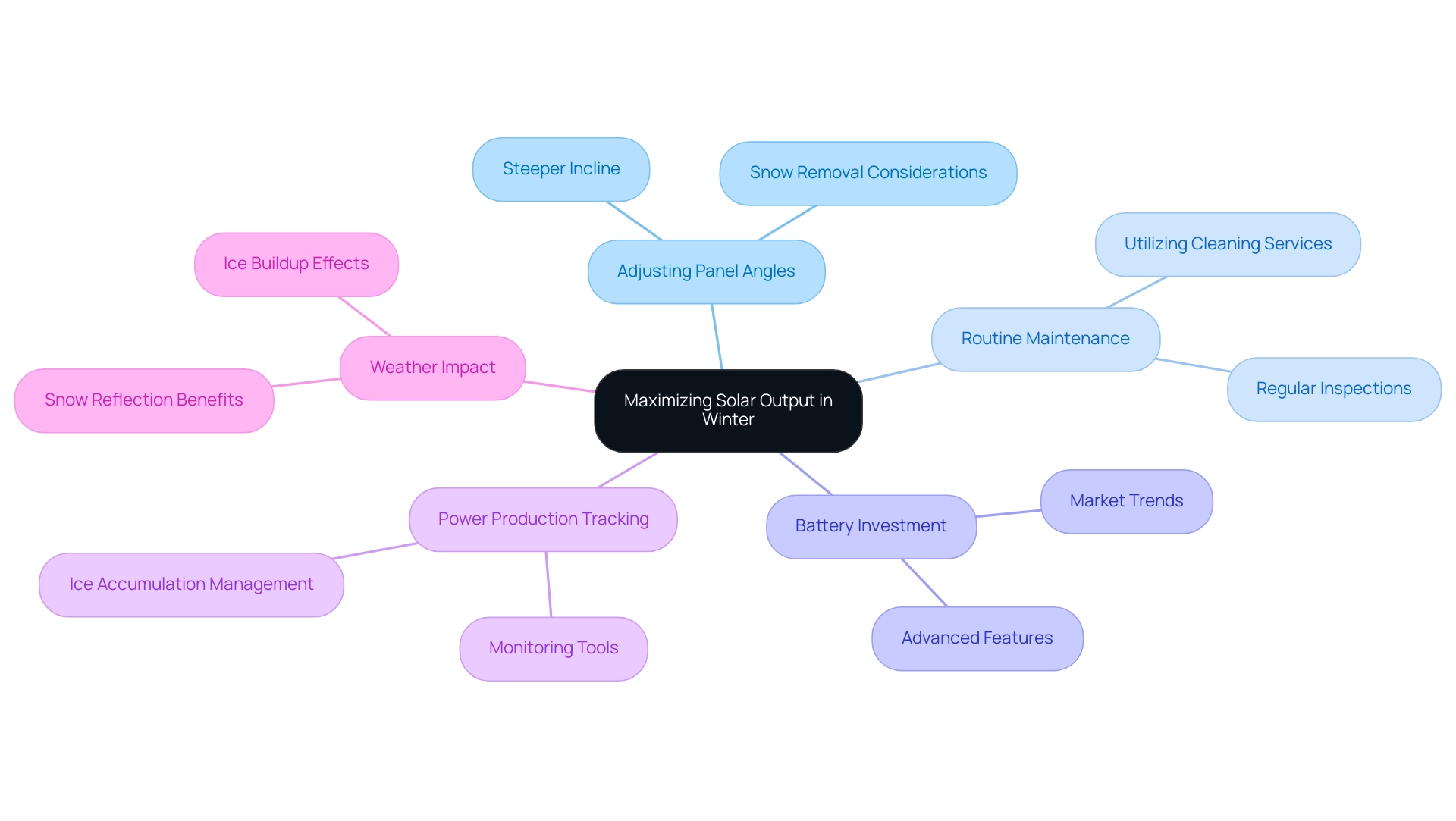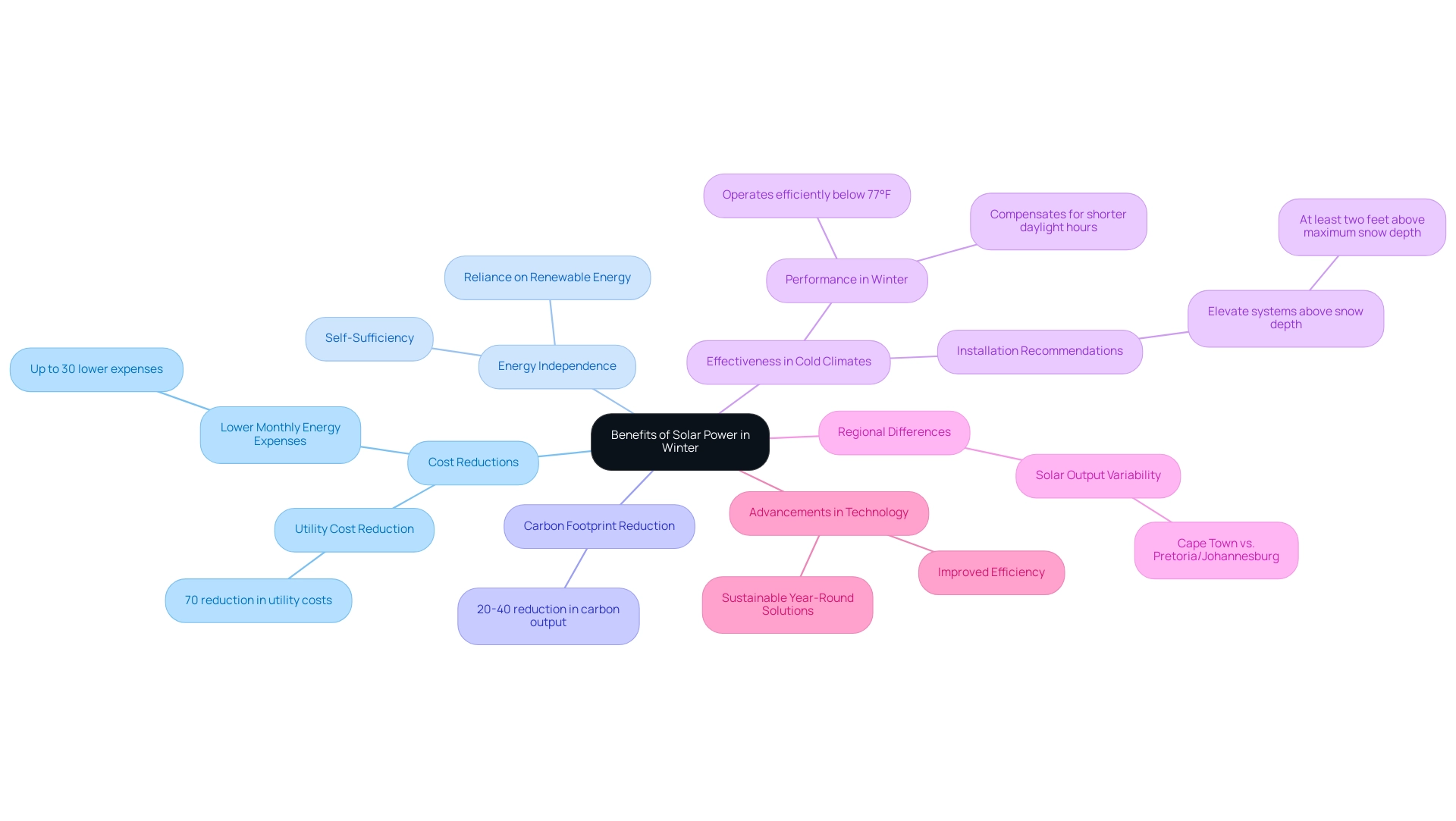Overview
We understand that many homeowners worry about energy bills, especially during the winter months. It’s important to know that solar power remains effective even in colder conditions. Photovoltaic systems can generate electricity efficiently, as they rely on sunlight rather than temperature. In fact, lower temperatures can enhance the efficiency of these systems. Studies show that they can produce up to 20% more electricity in colder weather. This resilience and adaptability across various climates demonstrate that solar energy is a sustainable solution worth considering.
By embracing solar energy, you can gain a sense of energy independence, reducing your reliance on traditional energy sources. Together, we can explore how solar power can benefit you, not just in terms of cost savings but also in contributing to a greener planet.
If you’re curious about how solar power can work for your home, let’s connect. We’re here to support you every step of the way. Remember, taking this step towards sustainable energy is not just about saving money; it’s about making a positive impact on the environment for future generations.
Introduction
As winter approaches, we understand that many homeowners may feel uncertain about the effectiveness of solar panels in the cold. It’s common to worry that these systems might be rendered useless by frigid temperatures. However, the reality is quite the opposite. Solar panels are designed to harness sunlight, and their performance can actually improve in colder conditions. This article delves into the science behind solar panel functionality during winter months, revealing how these systems continue to generate electricity despite shorter days and snow-covered surfaces.
With insights on maintenance strategies, regional performance, and the long-term benefits of solar energy, we invite you to discover not only the resilience of solar technology but also why winter can be an opportune time for investment in renewable energy solutions. Together, we can explore how embracing solar energy can lead to greater energy independence and help alleviate concerns about rising energy bills. Let’s work towards a sustainable future, ensuring that you feel supported every step of the way.
Understanding Solar Panel Functionality in Winter Conditions
Solar devices function by transforming sunlight into electricity, and their efficiency is affected more by sunlight availability than by temperature. We understand that during the cold months, many people wonder: does solar power work in the winter? The good news is that photovoltaic systems continue to generate electricity efficiently, even with shorter days and possibly less intense sunlight. A widespread fallacy is that photovoltaic systems are ineffective in chilly conditions; however, this misunderstanding disregards the basic principle that these devices capture sunlight, not warmth, for power generation.
As long as sunlight is available, photovoltaic systems will continue to generate electricity, which raises the important question: how well does solar power work in the winter?
Recent studies have indicated that these systems can still operate effectively in cold conditions, prompting an inquiry into how solar power works in the winter. For example, an extensive examination of 116 photovoltaic farms globally showed that solar power production continues even in cooler climates. Moreover, specialist views emphasize that the need for photovoltaic installations frequently decreases during winter, but as Emily Folk observes, this period can be a favorable opportunity for homeowners to invest in renewable technology, as it prepares the ground for energy savings all year round.
Practical examples further demonstrate this idea. In areas with substantial snowfall, photovoltaic systems have shown their capacity to produce electricity efficiently, even when blanketed by snow. The snow can slide off the surfaces due to their angle and smooth texture, allowing sunlight to reach the cells beneath.
Additionally, a case study named ‘Impact of Utility-Scale Photovoltaics on Vegetation and Moisture,’ concentrating on the Iberian Peninsula, revealed that although there was a moderate reduction in vegetation and moisture after installation (5% and 3%, respectively), the renewable energy facilities continued to operate effectively, demonstrating their durability in diverse environmental situations.
In conclusion, photovoltaic systems not only demonstrate their feasibility but also raise the important question of how solar power works in the winter, providing environmentally aware homeowners with a dependable source of clean power while aiding in long-term savings on utilities. Additionally, comprehending the ecological and environmental effects of photovoltaic power development can enrich the overall conversation on energy collector performance in winter, emphasizing the wider advantages of renewable technologies. Together, we can explore options like Tesla home chargers, which enable efficient energy utilization, government programs that endorse renewable energy initiatives, and battery storage solutions that guarantee energy availability during peak demand.
The Science of Solar Efficiency: Cold Weather vs. Performance
As homeowners, we understand that energy bills can be a significant concern, especially during colder months. Solar modules, made from semiconductor materials, exhibit varying efficiencies influenced by temperature, and it may surprise you to learn that lower temperatures can actually enhance the effectiveness of photovoltaic systems. When temperatures drop, the electrical resistance within these units diminishes, allowing for a more effective conversion of sunlight into electricity.
It’s common to wonder how well solar power performs in winter, given the shorter daylight hours. Studies reveal that while photovoltaic systems generate less electricity overall during these months, they can produce up to 20% more electricity in colder conditions compared to warmer weather. This increase in efficiency is primarily due to the fact that higher temperatures can elevate resistance levels, thereby reducing output.
Even though winter days may be shorter, the cooler temperatures can lead to improved performance of your energy collection devices. The ideal operating temperature for photovoltaic panels is around 77°F, yet they can function effectively in a range from -40°F to +185°F. This remarkable adaptability underscores the resilience of photovoltaic technology and reassures us that solar power remains a viable energy solution, even in colder climates.
To ensure that your energy system operates at peak efficiency during the colder months, regular professional cleaning is essential. Services like Sunshine Cleaners, Solar Shine, and Eco-Solar Clean offer tailored packages that focus on eco-friendly practices and innovative, waterless techniques. These services utilize specialized tools such as high-efficiency brushes and purified water systems to effectively eliminate dirt and debris without harming the surfaces.
By investing in professional cleaning, you not only enhance the efficiency and longevity of your energy systems but also contribute to a cleaner environment, maximizing your investment throughout the winter months. Moreover, understanding how photovoltaic systems function and the importance of routine upkeep can empower you to improve their efficiency and lifespan. Together, we can work towards a more sustainable energy future.
Snow and Solar Panels: Challenges and Solutions
We understand that many homeowners worry about how snow might impact their photovoltaic systems during winter months. While snow can temporarily block these systems, modern advancements in technology have equipped setups with features that enable effective snow shedding. This leads us to the important question: how well does solar power work in the winter? Powercore Electric’s solar units, designed with smooth surfaces and optimal angled installations, excel in managing snow accumulation. As sunlight reaches the surfaces, they generate heat, which aids in melting snow and raises the question of how well solar power works in the winter to restore energy generation.
To maximize performance during the colder months, it’s essential to consider how solar power works in winter and take several proactive measures. Adjusting the tilt of the panels to a steeper angle not only encourages snow to slide off more easily but is also crucial for maintaining efficiency. Research indicates that the optimal angle for maximum power output is around 27°, emphasizing the importance of proper installation.
Routine upkeep and sanitation are vital. Skilled experts from Powercore Electric can examine and service photovoltaic systems following severe weather occurrences, ensuring they stay in optimal condition and continue to provide savings on utility bills.
Recent studies underscore the effectiveness of bifacial photovoltaic modules in snowy conditions, revealing their ability to harness reflected sunlight from snow-covered surfaces. A case study titled “Performance of Bifacial PV Modules in Snowy Conditions” demonstrated that these modules could reduce annual snow losses from 16% to just 2% compared to traditional monofacial modules, highlighting their superior efficiency in cold climates. Powercore Electric integrates this innovative technology into their offerings, ensuring homeowners receive cutting-edge solutions that address the question of how solar power works in the winter.
We encourage homeowners to stay vigilant about snow accumulation and consider practical solutions such as installing snow guards or gently removing snow buildup with a soft broom. By adopting these strategies and depending on Powercore Electric’s customized and sustainable energy solutions, including professional installation and maintenance services, together we can ensure dependable energy production, address increasing energy expenses, and learn how solar power works in the winter, even in the coldest conditions.
Regional Performance: How Climate Affects Solar Energy Production
We understand that many homeowners worry about energy bills, especially in cooler regions where the efficiency of photovoltaic systems can seem uncertain. While colder months bring shorter daylight hours and lower sun angles, this does not necessarily equate to poor performance. In fact, photovoltaic systems can thrive even in winter, prompting the question: how does solar power work in the winter? Remarkably, regions like Massachusetts and Vermont have exhibited impressive power generation during severe cold months, showcasing the resilience of photovoltaic technology.
As we look ahead to 2025, advancements in photovoltaic technology have enabled enhanced efficiency in lower temperatures. This leads us to consider: does solar power work in the winter? The answer is a resounding yes, as these devices can still generate significant power despite seasonal challenges. Homeowners in these areas can benefit from understanding their local weather patterns and how they interact with energy systems. For instance, photovoltaic panels often perform optimally in cold, sunny conditions, which raises the inquiry: how does solar power work in the winter? The answer lies in the fact that lower temperatures can actually enhance their efficiency.
Moreover, regional statistics reveal a growing trend of renewable energy adoption, even in colder climates. This is supported by case studies from countries with diverse climates, such as Norway and Brazil, where renewable resources have been successfully integrated into the power mix. These regions have seen installations that not only meet energy needs but also contribute to overall energy independence.
At Powercore Electric, our in-house team of experts is dedicated to ensuring high-quality installations and maintenance, which is crucial for maximizing panel performance in varying climates. Our customers often share their satisfaction with our service. One client remarked, “Ryan and his team were great. They were quick, effective, and remained on schedule for our energy installation. I have referred Powercore to some friends, and they were also happy with their service. I’d definitely recommend Ryan and Powercore Electric.”
By utilizing local insights and advancements in photovoltaic technology, homeowners can effectively capture sunlight and understand how solar power works in the winter, even in the coldest months. Ultimately, it’s essential for homeowners to assess their specific climate conditions and consider customized solutions that align with their energy goals. The global implementation of photovoltaic systems continues to rise, reflecting a broader trend towards renewable resource adoption, as evidenced by India’s non-fossil fuel-based power capacity reaching 217.62 GW at the end of 2024.
By understanding these dynamics and partnering with a trusted provider like Powercore Electric, homeowners can make informed decisions about their energy systems. Together, we can navigate the journey towards energy independence, especially when compared to other providers who may not offer the same level of service and expertise.
Maximizing Solar Output: Tips for Winter Maintenance and Installation
To enhance energy output during the winter months, we understand that eco-conscious homeowners may have concerns about energy bills. It’s essential to grasp how solar power works in the winter and implement several key maintenance and installation strategies. One effective method to explore this is by modifying the angle of photovoltaic arrays to a steeper incline. This adjustment not only captures more sunlight but also aids in the removal of snow, ensuring that your system operates efficiently.
Routine maintenance of the panels is crucial. We encourage utilizing premier cleaning services to eliminate debris and snow, guaranteeing that efficiency is upheld and sunlight can access the photovoltaic cells without hindrance. Powercore Electric has been supporting the California community for over 30 years, offering expertise in renewable solutions. Investing in top-notch batteries is essential, as these systems can store surplus power generated on sunny days for use during cloudy or snowy periods. This consideration is particularly relevant when thinking about how well solar power works in the winter, especially during colder months when sunlight may be less reliable.
Assessing leading batteries, such as those with advanced features like longer life cycles and greater storage capacities, alongside understanding market trends and consumer considerations, can assist you in making informed choices. Tracking power production is essential; regular inspections can help detect any possible issues early, ensuring that your energy system operates at peak performance while understanding how solar power functions in winter months.
It’s important to note that while ice buildup can lower efficiency, understanding how solar power works in the winter is crucial for proactive management to mitigate these effects. For example, snow can actually boost power generation by reflecting extra sunlight onto the surfaces, which leads to the question of how solar power works in the winter, even though it might momentarily obscure them. Therefore, we advise against removing snow from the panels to avoid damage, as they are designed to withstand harsh weather conditions. Additionally, consider using monitoring tools to keep track of ice accumulation on your panels, ensuring that any buildup is managed effectively.
By adhering to these best practices and investigating accessible government initiatives for renewable solutions, such as incentives for installing Tesla home chargers, you can maximize your output and enjoy the advantages of sustainable resources, even in the colder months of 2025. Together, we can work towards a more energy-independent future.
The Long-Term Benefits of Solar Power in Winter: Myths vs. Reality
We understand that many homeowners worry about whether solar power is effective during the winter months. Contrary to popular belief, rest assured that sunlight power remains a viable and effective energy solution even in colder climates. It’s common to feel that cold weather diminishes the performance of photovoltaic panels, but this is a misconception. Numerous case studies highlight that photovoltaic systems yield significant long-term benefits, including substantial reductions in utility costs, enhanced energy independence, and a decreased carbon footprint.
For instance, a home in Southern California experienced more than a 70% reduction in their utility costs after implementing a water heating system powered by sunlight. This demonstrates the financial and ecological benefits of such heating technologies, showcasing how renewable energy can transform your home.
You might be wondering how well solar power works in winter, especially when temperatures fall below 77 degrees Fahrenheit. The good news is that the effectiveness of solar systems compensates for the shorter daylight hours characteristic of the season. For optimal performance in areas with significant snowfall, it’s important to consider how solar power operates in winter. Photovoltaic systems should be raised at least two feet above the maximum normal snow depth to enable effective power generation even in challenging conditions. Additionally, case studies show that passive power collection designs, such as using large south-facing windows, have demonstrated significant efficiency in cooler areas, highlighting the adaptability of renewable technology.
While regions like Cape Town may experience lower power output in winter compared to Pretoria and Johannesburg, homeowners have effectively decreased their utility bills by utilizing winter sunlight. This showcases the efficacy of these designs and the potential for savings. Moreover, advancements in technology continue to improve the efficiency and performance of solar panels, making them a sustainable option year-round. By investing in renewable energy, you not only enjoy the benefits of clean energy but also contribute to environmental conservation, regardless of the season.
As Ryan from Powercore Electric states, ‘Essentially, aside from saving you money on your electric bill, renewable energy can do it all, and turn your house into a more sustainable, low impact home.’ This commitment to sustainability and cost savings is further supported by Powercore Electric’s guarantee of high-quality installations and maintenance through its in-house team of experts. You can rely on this renewable resource, even as you wonder how solar power works in winter. Additionally, homeowners can expect to see a reduction in carbon output by 20 to 40 percent and lower monthly energy expenses by up to 30%, reinforcing the value of solar energy solutions.
Together, we can navigate the path to a more sustainable future, ensuring that your home is equipped to harness the power of the sun all year round.
Conclusion
We understand that many homeowners may feel uncertain about the effectiveness of solar panels during the winter months. However, it’s important to know that solar technology is both robust and effective, even when temperatures drop. In fact, colder conditions can actually enhance the efficiency of solar panels, enabling them to produce electricity even with shorter daylight hours and snow-covered surfaces. By implementing proper installation and maintenance strategies—such as adjusting panel angles and ensuring regular cleaning—solar systems can continue to function effectively, providing a dependable source of renewable energy throughout the winter.
Moreover, let’s consider the regional performance statistics that show solar energy thriving in colder climates. Successful installations in states like Massachusetts and Vermont serve as inspiring examples of solar adoption, even in challenging weather conditions. These instances highlight the resilience of solar technology and its ability to adapt. Additionally, advancements in solar design, including bifacial modules that utilize reflected sunlight, significantly reduce energy loss caused by snow, further enhancing performance.
Investing in solar power not only yields immediate benefits in terms of energy savings but also supports long-term environmental goals by lowering carbon footprints and fostering energy independence. As you contemplate your energy options, the case for solar becomes increasingly compelling, especially in the winter. By embracing this renewable energy solution, you can enjoy both economic advantages and the rewarding feeling of contributing to a more sustainable future. Together, let’s work towards a brighter, greener tomorrow—one solar panel at a time.


